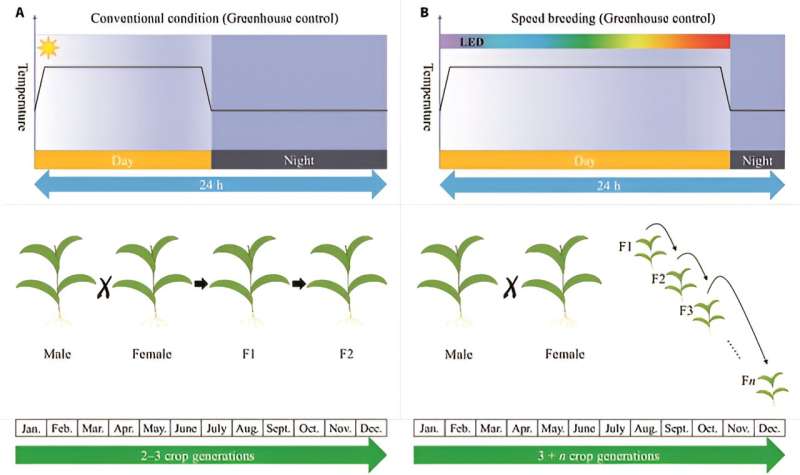This article has been reviewed according to Science X's editorial process and policies. Editors have highlighted the following attributes while ensuring the content's credibility:
fact-checked
proofread
Harnessing speed breeding and model optimization for sustainable crop development

The rising global population, projected to reach 10 billion by 2050, is anticipated to double the demand for food, especially animal-based products. This surge in demand is set to intensify pressure on agricultural resources, posing additional challenges amid the backdrop of climate change.
To meet these demands, the development of high-yielding, resilient crop varieties is crucial. Speed breeding (SB), a technique that accelerates crop generation through controlled environmental conditions, has emerged as a promising solution. Pioneered in the 1980s and advanced recently, SB allows for rapid crop modification and increased crop generation frequency. However, challenges remain in optimizing the environmental conditions for SB, such as light, temperature, and water resources.
Plant Phenomics published a review article titled "Crop/Plant Modeling Supports Plant Breeding: I. Optimization of Environmental Factors in Accelerating Crop Growth and Development for Speed Breeding."
This review focuses on the use of crop and plant models to identify ideal conditions for SB, arguing that these tools are vital for customizing and enhancing SB protocols to rapidly develop stress-resistant, high-yielding crops.
This review delves into the transformative potential of SB in revolutionizing crop development, emphasizing its ability to significantly shorten the time required for breeding new crop varieties. SB achieves this by manipulating environmental factors like photoperiod, light quality, intensity, and temperature, relieving constraints imposed by lengthy traditional breeding processes.
Successful implementations in wheat, rice, and barley demonstrate the effectiveness of SB, where traits like disease resistance and plant height have been rapidly improved. However, the efficacy of SB hinges on the optimization of these environmental conditions, a task that remains largely empirical and thus ripe for refinement. Photoperiod is identified as a crucial regulator in SB, influencing critical growth stages and photosynthetic efficiency.
Other factors, including light intensity, quality, and temperature also play significant roles in determining SB performance. This underscores the need for a comprehensive understanding and precise control of these factors to minimize generation time without inducing growth disorders. Furthermore, the review acknowledges that current SB practices heavily lean on published literature and individual experiences, revealing a lack of precision and standardization in environmental setups.
To address these gaps, crop and plant models are introduced as robust tools for predicting growth and development under various environmental conditions. These models enable virtual trials, facilitating the rapid determination of optimized environmental conditions to achieve desired plant phenotypes.
The integration of artificial intelligence is proposed as a means to further enhance the predictive accuracy and efficiency of these models. However, challenges persist. Existing models often do not accurately represent the unique conditions of greenhouses or the specific requirements of SB.
They need to be calibrated or modified for different crop types and conditions. Moreover, most models do not adequately capture the effects of light quality on plant growth, an area that requires further research and development.
In conclusion, while SB presents a promising avenue for rapidly developing new crop varieties, its success is contingent upon the precise optimization of environmental conditions.
Crop and plant models, especially when augmented with AI, offer a pathway to achieving this precision. As these tools evolve and adapt, they are expected to play an increasingly crucial role in realizing SB's potential, thereby contributing to future food security by enabling the efficient development of improved crop varieties.
More information: Yi Yu et al, Crop/Plant Modeling Supports Plant Breeding: I. Optimization of Environmental Factors in Accelerating Crop Growth and Development for Speed Breeding, Plant Phenomics (2023). DOI: 10.34133/plantphenomics.0099
Provided by Plant Phenomics





















